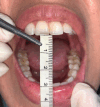Eficacia de la fotobiomodulación en el manejo del dolor agudo en trastornos temporomandibulares: Estudio de serie de casos
- PMID: 40612421
- PMCID: PMC12217055
- DOI: 10.21142/2523-2754-1302-2025-245
Eficacia de la fotobiomodulación en el manejo del dolor agudo en trastornos temporomandibulares: Estudio de serie de casos
Abstract
Introduction: Diode láser photobiomodulation has been applied as a non-invasive technique to treat temporomandibular joint (TMJ) symptoms, especially in the relief of acute painful conditions.
Objective: To evaluate the effect of photobiomodulation in the management of acute pain and mouth opening in patients with TMJ disorder.
Methodology: 12 patients diagnosed according to the "Diagnostic Criteria for Temporomandibular Disorders (DC/TMD) for Clinical and Research Applications of the International RDC/TMD Consortium Network of the International Association for Dental Research and the Special Interest Group were included. in orofacial pain from the International Association for the Study of Pain", after signing the informed consent. All patients were irradiated using Gemini EVO Ultradent dual diode láser, using an extraoral irradiation protocol of 0.2W over the TMJ and 1W when the patient reported muscle pain over the symptomatic area, with a total of 6 sessions. Pain intensity was rated using a numerical scale (VAS). Mandibular function was evaluated by the maximum unassisted mandibular opening measured in mm. Data were analyzed using a mixed model analysis of variance (ANOVA). Values p<0.05 were considered statistically significant.
Results: Pain intensity statistically decreased from 7.52±1.18 to 2.13±1.33 (p<0.001) from the first to the last session. TMJ region showed a reduction in pain from 6.25 ± 2.83 to 1.5 ± 1.50, in the temporalis muscle from 7 ± 1.85 to 1.66 ± 1.30, in the pterygoid from 6.25 ± 2.99 to 1.25 ± 1.15 and, in the masseter 6.83 ± 1.80 to 1.41 ± 1.31. Regarding mouth opening, the function statistically increased from 32.05±4.3mm to 42.66±1.6mm (p<0.001).
Conclusions: Pain intensity and mouth opening in patients with TMJ disorder improve substantially after láser photobiomodulation treatments.
Introducción:: La fotobiomodulación con láser diodo se ha aplicado como una técnica no invasiva para tratar los síntomas de la articulación temporomandibular (ATM), especialmente en el alivio de condiciones dolorosas agudas.
Objetivo:: Evaluar el efecto de la fotobiomodulación en el manejo del dolor agudo y la apertura bucal en pacientes con trastorno de la ATM.
Metodología:: Fueron incluidos 12 pacientes diagnosticados según los criterios de diagnóstico para los trastornos temporomandibulares (DC/TMD) para aplicaciones clínicas y de investigación de la Red del Consorcio Internacional RDC/TMD de la International Association for Dental Research y el Grupo de Interés Especial en Dolor Orofacial de la International Association for the Study of Pain, tras la firma del consentimiento informado. Todos los pacientes fueron irradiados usando un láser diodo dual Gemini EVO Ultradent, y se usó un protocolo de irradiación extrabucal de 0.2W sobre la ATM y 1W cuando el paciente refería dolor muscular sobre la zona sintomática, con un total de 6 sesiones. La intensidad del dolor se calificó usando una escala numérica (EVA). La función mandibular se evaluó mediante la máxima apertura mandibular sin asistencia medida en mm. Los datos fueron analizados mediante un análisis de varianza de modelo mixto (ANOVA). Los valores p < 0,05 fueron considerados estadísticamente significativos.
Resultados:: La intensidad de dolor disminuyó estadísticamente de 7,52 ± 1,18 a 2,13 ± 1,33 (p < 0,001) de la primera a la última sesión. A nivel de región de ATM hubo una reducción de dolor de 6,25 ± 2,83 a 1,5 ± 1,50; en el músculo temporal, de 7 ± 1,85 a 1,66 ± 1,30; en el pterigoideo, de 6,25 ± 2,99 a 1,25 ± 1,15; y en el masetero, de 6,83 ± 1,80 a 1,41 ± 1,31. Con respecto a la apertura bucal, la función aumentó estadísticamente de 32,05 ± 4,3 mm a 42,66 ± 1,6 mm (p < 0,001).
Conclusiones:: La intensidad del dolor y la apertura bucal en pacientes con trastorno de la ATM mejoran sustancialmente después de los tratamientos de fotobiomodulación láser.
Keywords: diode láser; láser therapy; orofacial pain; photobiomodulation; temporomandibular disorder.
Conflict of interest statement
Conflictos de intereses: Los autores declaran no tener ningún conflicto de intereses.
Figures







References
-
- Mallya SM, Ahmad M, Cohen JR, Kaspo G, Ramesh A. Recommendations for Imaging of the Temporomandibular Joint. Position Statement from the American Academy of Oral and Maxillofacial Radiology and the American Academy of Orofacial Pain. J Oral Facial Pain Headache. 37(1):7–15. doi: 10.11607/ofph.3268. - DOI - PubMed
-
- National Academies of Sciences, Engineering, and Medicine. Health and Medicine Division. Board on Health Care Services. Board on Health Sciences Policy. Committee on Temporomandibular Disorders (TMDs): From Research Discoveries to Clinical Treatment . In: Temporomandibular Disorders: Priorities for Research and Care. Yost O, Liverman CT, English R, Mackey S, Bond EC, editors. Washington (DC): National Academies Press (US); 2020. - PubMed
-
- Dammling C, Abramowicz S, Kinard B. The use of pharmacologic agents in the management of temporomandibular joint disorder. Front Oral Maxillofac Med. 2022;4:17–17. doi: 10.21037/fomm-20-37. - DOI
-
- Jácome A do N, Sousa J de SM, Resende CMBM de, Barbosa GAS, Araújo AA de, Almeida EO de. Effectiveness of manual physical therapy and /or mandibular exercises in the treatment of the articular temporomandibular disorder - a systematic review. RSD. 9(10):e1729108485. doi: 10.33448/rsd-v9i10.8335. - DOI
Publication types
LinkOut - more resources
Full Text Sources
